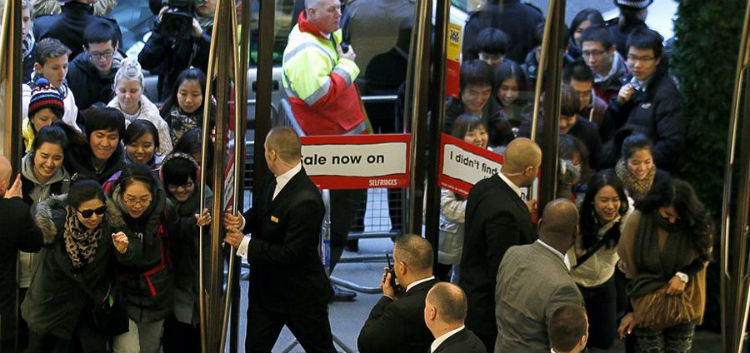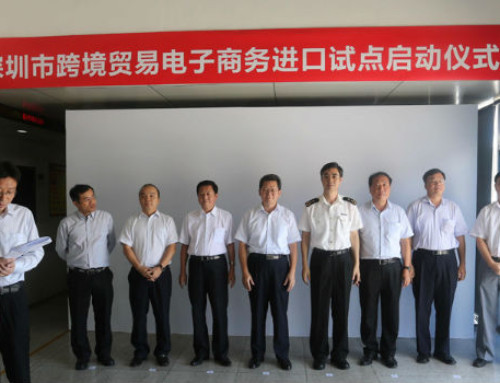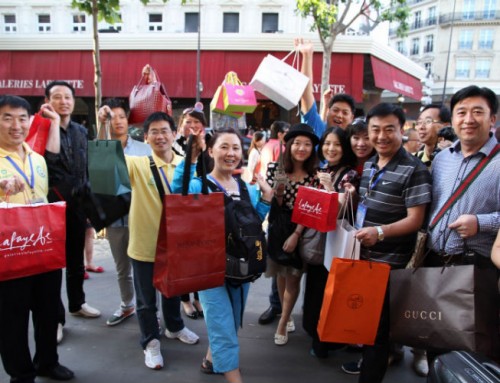For roughly three decades, China’s booming economy has offered consumer product companies some of the world’s greatest growth opportunities. China’s economic slowdown and jittery markets have raised worries that this growth story is drawing to a close. In early November 2015, for example, the government lowered its official five-year annual GDP growth target to 6.5%, the slowest pace since the 2008–2009 global financial crisis.
China’s economy is indeed struggling through a significant structural transition, and consumption isn’t rising as fast as it did during the peak boom years. But make no mistake: although the pace is slower and the course is bumpier, consumption growth is still tracing a staggering trajectory. China’s consumer economy is projected to expand by about half, to $6.5 trillion, by 2020 — even if annual real GDP growth cools to 5.5%, below the official target. And the potential for rising sales of consumer goods extends far beyond China’s first-tier cities and into its vast hinterland, where 80% of the population lives. The government’s goal was to double per-capita income by 2020, giving households additional cash, and consumption a much-needed boost.
Attracted by the huge potential of China consumer goods market, many foreign companies are planning to enter China market, the following are 5 points that can help you develop an effective market entry strategy.
1. China consumer goods market is full of challenges.
China is one of the most discussed topics in the multinational business community. Because of the country’s vast size and huge development potential, many multinational consumer product companies believe they must compete there. Yet the special characteristics of the China consumer goods market have made a presence challenging at best and often frustrating. China’s size, diversity and rapid change, not to mention its culture and the broad influence of its Government, all contribute to a difficult operating environment.
On top of these factors, competition in many consumer goods sectors is intense. Local players, leading multinationals and overseas Chinese companies are all vying for business from the country’s huge pool of consumers. Companies are applying and testing various strategic and operating approaches in this rapidly evolving market. Indeed, China’s consumer goods market has become a dynamic business laboratory, one in which some multinational companies have found early success but even more have been losing significant amounts of money.
Despite the mixed results, most major multinational companies still regard China as an important opportunity that they do not want to give up. For many, they are currently deciding whether they can grow their business profitably in China consumer goods market. Making that leap, however, will be a major challenge. The factors involved in China consumers goods market — consumer, market, product, competition, sales and distribution, retail, organization and human resources — are all changing. They are too complicated to be dealt with individually, yet they are often interrelated so that they must be considered on an integrated basis.
One thing is clear: China consumer goods market is strategically attractive to many multinationals. The country’s demographics and long-term economics are overwhelming in terms of their potential. Chinese consumers are already migrating from basic products to more sophisticated, more expensive ones. Their decision-making can be influenced. Further, the consumer industry is, by and large, a level playing field for the participants, especially in the fast-moving consumer goods market. Its regulatory environment is the most liberalized in China.
Combined, these factors have made China a major imperative for most big multinationals. Indeed, for some, such as Coca-Cola, Procter & Gamble and Starbucks, China has become one of their largest markets in Asia, or even the world.
2. There are huge geographic differences across China consumer goods market.
The best way to look at China consumer goods market now is as a series of local consumer goods markets, each with thousands of different outlets for goods and a broad mix of channels, including modern trade, such as large chain stores (e.g., Carrefour); traditional trade (local mom-and-pop stores); and on premises (restaurants, schools, and Internet cafes). Further, there are huge geographic differences as companies move across China:
- North China: Several relatively wealthy Tier One cities, such as Beijing, Tianjin, and Xi’an, and a large number of less developed cities and counties.
- East China: Many sophisticated consumers and a partiality to Westernized lifestyles and tastes in cities like Shanghai and Nanjing.
- South China: Economically developed and very urbanized. In addition to such megacities as Guangzhou and Shenzhen, there are many small but well-developed Tier Two cities like Dongguan and Shantou.
- West China: The least developed area with the largest rural population, lowest income levels, and most underdeveloped transportation infrastructure.
Though this analysis is valuable as a starting point for entering China consumer goods market — for example, customers in different regions have contrasting tastes and budgets — it is important not to be too rigid about its conclusions. Each of these regions is significantly fragmented — they are not monoliths. Further, their configuration is not static. To illustrate, as the government accelerates its investment in the rail system, the distinctions between megacities and/or tiers will shift even more rapidly.
The China consumer goods market is mapped out, and foreign companies must first create an overall strategy for marketing their products in suitable channels and geographic segments. This strategy should include a plan for offering the right product assortment, providing differentiated in-store execution, negotiating lucrative profit margins and commercial terms, and designing appropriate service levels and logistics models.
In developing optimal value propositions, foreign companies must, for example, contrast the needs of traditional trade (mom and pop) stores in a Tier Three city and a Tier One city. In Tier Three, where consumers are less flush than in the bigger urban areas, the store may prefer a narrower product line with smaller (and cheaper) packages that are presorted and can be “dropped” onto shelves easily. The same store located next to an Internet bar in a Tier One city would more likely support a wider range of products with much larger package sizes.
Moreover, order sizes in Tier One may be sufficiently large and deliveries sufficiently frequent that serving these outlets directly (rather than through a wholesaler) is a much more profitable approach—and provides for much more control.
Emerging mini-markets in lower-tier cities illustrate another fresh set of assessments that foreign companies must make. These outlets typically follow open-shelf supermarket-style formats but are stand-alone stores like mom-and-pop operations, not the organized chains usually found in more developed regions. Because they are something of a hybrid (part modern trade and part traditional trade), mini-markets require unique market entry approaches, such as sophisticated product assortment, promotion, and point-of-sale support with little standardization in order volumes and logistics.
3. Timing and Opportunity vary by specific product market.
While the potential of the Chinese consumer goods market is sizable, the timing and the paths required to realize the potential vary by product market sector. The evaluation of the opportunity in each product market is a function of not only the threshold income but also other enablers. Threshold income may well predict the first purchase of “basic necessity” products, such as refrigerators and washing machines. But as households possess these products, consumer choices shift to more discretionary products. Products of different categories may now compete for a “share of the wallet.” Consumers’ purchases of big-ticket items like passenger cars are beginning to take place but are still limited today. Furthermore, opportunities in a well-penetrated urban market may be very different from those in a “virgin” suburban or rural market. The Chinese situation is too complicated to draw a simple overall picture of the product market opportunities.
Companies need to evaluate the opportunities carefully on a specific product market basis. Companies should decide their objectives in China and understand the ramifications of their decisions. Do they want to have broad-based product offerings in China or focus on niche products? Do they want market share or immediate financial return? Do they want to build up the critical mass of their businesses now or later? Do they want to focus on just the top three cities or penetrate a broad geographical area? The answers to these questions vary by company and by product market. For instance, Procter & Gamble and Unilever want to be big throughout China and are willing to invest. This probably makes sense because these companies sell “daily use” products that many Chinese consumers are already able to purchase. On the other hand, the timing and opportunity for “big ticket” consumer goods may be different. Companies must discern this difference and be careful in over extrapolating from the data and experience in one industry sector to another.
4. An online presence in China is a must.
Online consumer goods sales in China are high compared to other emerging markets in Asia. As well as having their own Chinese websites, brands are increasingly appearing on online malls such as JD.com and TMall. A mobile strategy is also a necessity — mobile internet retailing grew by 162% in real terms in 2014. Business to Consumer Internet retail sites have some important advantages over the dominant consumer to consumer retail sites, particularly in terms of quality and the confidence they engender in consumers wary of counterfeit goods. Mobile internet subscriptions will surpass 50% of all mobile phone subscriptions in 2019.
Sephora, a global beauty retailer has extended its online presence in China by opening a “flagship” store on JD.com. Despite a large bricks and mortar presence, having opened its first store in Shanghai in 2005, and a Chinese version of its website, the company hopes this move will increase its visibility amongst Chinese consumers. Consumers are also able to share online shopping experiences on WeChat and Sina Weibo and the company launched its mobile apps in both iOS and Android platforms in 2013. In 2014, Sephora had a 10.4% share of the beauty specialist retailing sector in China.
5. Chinese consumers loyalty is fleeting.
Chinese want the newest, most desirable products available. They tend to trust celebrities when making a buying decision. And their loyalty is fleeting: According to a survey of 40,000 households concluded that Chinese buyers seldom form attachments to specific branded products. The more often they shopped within a particular product category, the more different brands they were likely to try.
Foreign companies entering China consumer goods market can do several things to confront this difficulty. First, they may need to re-evaluate the effectiveness of affinity and loyalty programs, acknowledging the tendency of Chinese consumers to try out a range of products, and then tailor promotions to accommodate that tendency. Bricks-and-mortar stores may find it prudent to stock only the top-selling items. It is found that, despite consumers’ desire to try different brands, a handful of best-selling items accounted for the bulk of retailers’ revenue. Multinationals will compete more effectively with local stores by increasing the frequency of shopping trips that consumers make and the range of product categories they sample — again, most likely through promotions tailored to the tastes of local buyers.
Related reading: 9 Keys to Successfully Sell Your Product to China













